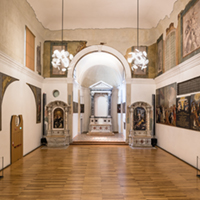
San Teonisto church
The restoration of the building in Treviso’s historical centre, strongly supported by Luciano Benetton, is now completed and hands back to the town an important historical asset for cultural events.
The complex project – launched at the end of 2014 and entrusted to the care and creativity of architect Tobia Scarpa following his productive partnership with the Benetton Group – restores a renewed architecture, yet still capable of showing the marks of its past as a place of worship, which was seriously damaged by the bombings in 1944 and stripped of its furnishings, and eventually forgotten. Subsequently de-consecrated and used for a variety of purposes, the building was managed by Treviso’s Municipality up to the acquisition in 2010 by Luciano Benetton, who later donated it to Fondazione Benetton Studi Ricerche to turn it into a cultural venue designed to host international events.
The church owes its name to St. Theonist, whose body was reportedly transferred to Treviso by the people of Altino after their town was destroyed by Attila in 452 AD.
Along with the remains of the saint, over the centuries the church held a number of paintings by 17th century artists, including the famous painting Marriage at Cana by Paolo Veronese and workshop, now in Palazzo Montecitorio, and the great 18th century fresco on the ceiling by Guarana, depicting the Assumption of the Virgin, whose fame echoed through all the cultural milieus of the time. Many works were stolen in 1810 after the arrival of Napoleon and some of them are now held by the Santa Caterina Museum of Treviso and the Brera Picture Gallery.
The restoration and adaptation of the church had, as its primary objective, the respect and protection of the existing architectural space through the implementation of targeted restoration techniques and accurate details drawn by Tobia Scarpa himself. A solution to the new functional needs was found by constructing two foldaway stands that, when raised, turn the church chamber into a concert hall and auditorium with a total capacity of 300 people. By laying a new raised floor and thanks to painstaking excavation work, the foldaway stands can be fully concealed, as they disappear under the floor and thus allow completely free space to be obtained for temporary exhibitions.
The new ceiling, which follows the original layout of the one that collapsed during World War II, is held up by a special structure of metal beams tied to the perimeter walls and made independent from the wooden truss roof above it. The original stuccoes in the former sacristy, next to the chamber, have been recovered by integrating the missing parts with thorough restoration work, while the adjacent area houses the utility rooms.
The entire church complex can be accessed from a small courtyard that acts as an open-air foyer featuring an installation of four columns, three of which are topped by an ancient Ionic capital and one by a screen-printed glass sculptural replica of the original bas-relief that inspired the official logo of Fondazione Benetton Studi Ricerche.
The entire project is furbished with all the architectural details designed by Tobia Scarpa, including the four blown glass chandeliers in the chamber, the seats in the stands and parterre, the layout of the entrance courtyard and the new iron and wood staircase of the former sacristy.
The significant architectural-structural work has been complemented by the restoration of nearly all the original paintings, which were then placed back in their original positions thanks to a thirty year agreement between Fondazione Benetton and the Municipality of Treviso, in whose Civic Museum collections the canvases had been held, after they were removed from the church following the bombings.
Between the end of 2022 and the beginning of 2023, the church underwent a new phase of technical adaptation works and the restoration of the tympanum on the façade, as well as another important cultural operation: the acquisition of three new canvases that complete the artistic cycle where the original paintings could not be recovered.
Safet Zec, a Bosnian artist considered by international critics to be a painter and engraver of extraordinary expressive qualities, has been entrusted with the task of interpreting and giving new life to those empty spaces along the walls, choosing the language of contemporary art to continue that dialogue with the antique already begun, in the field of architecture, with Tobia Scarpa’s critical restoration.
The three large canvases made specifically for the church are The View of Treviso, designed for the lunette above the side entrance, dedicated to the memory of the tragic bombings of the two world wars; The Embrace, for the side altar on the opposite side, a work that takes up a recurring and poignant theme, very dear to the artist; The Tree, for the high altar, an unusual subject that explodes in all its luxuriant vigour, a large stupefying tree crown that invades the space with light and colour, a sort of hymn to joy that has the force of an overwhelming and liberating symphony.
Today, the church provides a cultural venue designed to host international events, the schedule of which is managed by Fondazione Benetton.
